This is the first of a series of blog posts about writing - and about assisting all students to become stronger writers.
Let's start by talking about the very beginnings of writing.
Early Emergent Writing: Focus on Function
Mathilda is 17 months old. She loves drawing - and her parents are pretty happy when she draws on the things she's supposed to draw on, like paper!
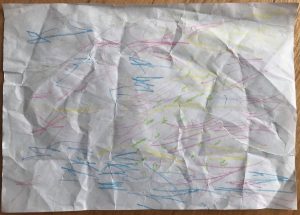
She takes this drawing to her Dad, knowing from past experience that he'll be pleased. He loves it and starts talking to her about it. "What is it?". "Rainbows and trees" replies Mathilda. "Oooh" Dad says "a big green one, and some blue ones, and yellow and red. Wow. And I think I can see a t for tree over here. Great writing. Go Mathilda." Her Dad is pleased and Mathilda loves that he is pleased and will, without doubt, do this again. And, just as importantly, Mathilda has taken some of her first steps in becoming a writer.
Over the next several months, this sort of interaction happens many times. Her Mum, her Dad, her grandparents, the staff at child care, all make similar comments on Mathilda's drawing/writing. All these adults in her life show a huge amount of expertise in two really important skills. These are the emergent literacy adult superpowers: presuming competence and attributing meaning.
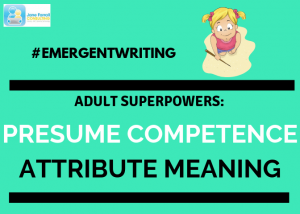
Presume Competence
This is something that we do with young children all the time. We presume competence because we expect them to become readers and writers. With every interaction, we teach them that we believe in them and that we have high expectations of them - we "believe" that there is an "t" in their writing even though there isn't. But, by doing so, we make it more likely that there will be an "t" in the future and we send them a clear message that we know they can do it. We need to do this with ALL emerging readers and writers to convey the same beliefs and expectations. Our actions in presuming competence teach them that they are writers!
Attribute Meaning
Again, this is something we do with young children all the time. We attribute meaning to all their literacy attempts. By doing this we teach them that print has meaning - and that it always has meaning. It also teaches them that everything they say they can write.
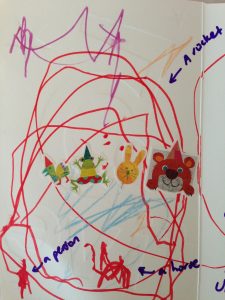
14 months later, Mathilda is still consolidating her understanding of these functions of print - and is almost ready to move onto learning about form. She has now had lots practice of writing/scribbling and having others attributing meaning to it and assuming competence. The picture above is a birthday card she "wrote" for her cousin when she was 2 years and 4 months old.
Other Early Writing and Literacy Experiences
At the same time that Mathilda is becoming a budding writer, she is also learning a lot about the functions of literacy through other experiences.
She sees adults writing and reading, which reinforces her understanding that print has meaning. When her Dad takes the shopping list to the supermarket and Mathilda watches him refer to it again and again as he adds items to the trolley, this reinforces that understanding. When she sees her Mum open a bill and become annoyed by the contents - this reinforces that understanding. Every time her favourite book is read to her and she hears the same story, this activity reinforces that understanding. And over and over again, through all these experiences, she learns that print always has meaning.
Seeing adults reading and writing also reinforces her understanding that everything we say we can write. Her Mum opens the fridge and says "oh no - we're out of milk" and then writes it on the shopping list - demonstrating that function of print. She helps her parents write Christmas cards, and learns again in this situation that what we say, we can write. The childcare staff take a bunch of photos and write captions under them, after talking about what they could say. And, once again, this reinforces that everything we say we can write. And she learns, over time, that text is a code for speech - and that if we can say it we can write it.
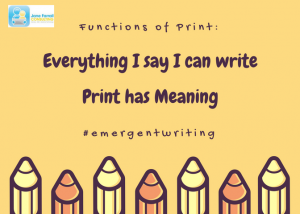
And while she has all these experiences, she continues to "write" (or scribble), with opportunities happening daily, and she builds a really solid belief that she is a writer - and that everyone around her thinks she is too.
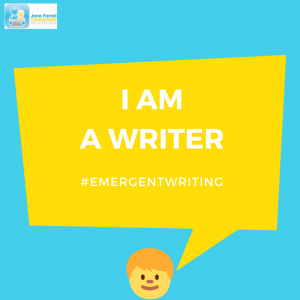
Moving ahead in time and Mathilda is now 2 years and 6 months old. She has had a lot of interactions with print on her own and with other people. And in the two months since the last sample she has made a little bit of a jump. This postcard to her Dad is starting to show a little bit of difference in her writing and her drawing - and I'm pretty sure that her amazing mother, Yvette, made lots of positive comments about the "M" shapes appearing in her writing, and particularly the M appearing in her name signed at the bottom. This is the first indication that Mathilda is starting to take notice of the forms of print - after 16 months of practice, attributing meaning and assuming competence and ALL those other literacy experiences tied in together. (Plus some playing with the alphabet as well).

And to finish this first post off, here's a video of Mathilda writing at 3 years old. This video is where I plan to start the next blog post - but I'm also using it in this blog post it demonstrates so clearly that there is no doubt in her mind that she is a writer. It also shows clearly that she has also learned those two important functions of writing:
- Print has meaning
- Everything I can say, I can write
(And, as you can see from her wavy lines, she is starting to move ahead with the "form" of writing - but that's the topic of the next blog post.)
Emergent writing and students with disabilities
Some of you will have read this blog post, and possibly have thought about a Mathilda of your own while reading it. Some of you might be wondering what this has to do with special education students.
This blog post has everything to do with EVERY emergent writer. In the history of special education we have tried to bypass emergent writing because we haven't understood how important it is. Or, because we have mistakenly thought that because a student is school age that we should be making their writing "look appropriate". When I first started working as a speech pathologist in special education settings, nearly 30 years ago, the majority of writing "instruction" was about copying. We had students copying who didn't believe they were writers and who had never had an opportunity to scribble. We didn't teach them about the functions of print - we just taught them to copy. We never taught them that print was a code for speech. We didn't teach them those basic functions of print that allow individuals to develop as writers. At 2.5 years of age, Mathilda can generate an idea and some language and then "write" it. But those students never learned that ideas and language underlie all writing because all we taught them was how to copy. Their writing "looked" a lot more like writing than Mathilda's - it had letters and words - but it wasn't really writing. And we all knew that. So many students from that period only learned one thing about writing - which was that they were a failure at it.
We now have over 10 years of implementing emergent writing with emergent readers and writers of all ages. We have figured out a whole range of alternative pencils that they can use so that we can give them the same emergent writing experiences that Mathilda got. We recognise that many students with disabilities need more emergent writing experiences to become writers. And our job is to figure out how to get those experiences happening with every emergent writer at any age. So that every student can develop an understanding of those important, underlying functions of print as a solid foundation for their writing development.
And, as always, I have to thank the Centre for Literacy and Disability Studies, Karen Erickson, David Koppenhaver and Sally Clendon for everything they have taught me. And an HUGE thank-you to Mathilda and her family for being so awesome.
Next blog post: Emergent writing: Moving onto form
PS If you want to see another delightful example of a three year old writing and demonstrating his understandings of the functions of print check out this video which was shared by two of my friends on Facebook yesterday.


Jayne
Laura
jane
Pingback: Emergent Writing: Moving onto Form | Jane Farrall Consulting
Pingback: Using the Developmental Writing Scale for Writing Assessment | Jane Farrall Consulting
Laura Jones
jane